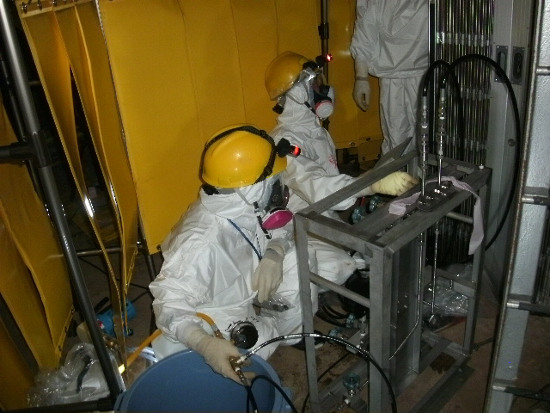Accumulated contamination of Fukushima workers is still high
Tokyo Electric Power Company (TEPCO) said on March 1 that the cumulative radiation exposure of workers at the Fukushima No.1 Nuclear Power Plant for a period of one year from March 2012 was four times higher than with before the disaster in March 2011.
The total number of workers' exposure doses is displayed in units of 'man-sievert .' According to TEPCO calculations, cumulative exposure doses from March 2012 to January 2013 amounted to 60.1 man-sievert. or the average annual exposure of 65.6 man-sievert, which is four times higher than the 14.9 man-sievert measured in 2009.

Workers check the reactor indicators at Fukushima Nuclear Power Plant 1.
Compared to 246.9 man-sievert in the first year from March 2011 to February 2012, the second year fell to just one-fourth the first year after the disaster. However, this level is still high compared to the specified level in other commercial nuclear power plants in Japan, currently at 46.3 man-sievert in fiscal year 2011.
At the Fukushima nuclear complex, the average exposure dose was about 12,100 workers at 4.6 millisievert (mSv) during the period from April 2012 to January 2013, while the highest dose of them reached 46, 59mSv.
The maximum radiation dose for power plant workers is 100mSv within 5 years and 50mSv / year. However, the annual allowable exposure limit was pushed to 250mSv after the March 2011 disaster, but it was brought back to 50mSv in December 2011.
- Fukushima workers died not because of radiation
- Japan acknowledged the first death due to radiation at Fukushima
- Radioactivity in Fukushima is so high that the probe camera's camera is burned
- Decontamination work around the Fukushima Plant was three years late
- Half of Fukushima children are radioactive
- The Fukushima disaster caused serious ocean contamination
- Infected wild boar flooded Fukushima street
- Japan planted radiation-resistant sunflowers
- The danger remains at the Japanese nuclear power plant
- Fukushima children are exposed to radiation below the danger threshold
- There are unusual butterflies in Fukushima
- Very high radiation index at Fukushima
 Is the magnetic North Pole shift dangerous to humanity?
Is the magnetic North Pole shift dangerous to humanity? Washington legalizes the recycling of human bodies into fertilizer
Washington legalizes the recycling of human bodies into fertilizer Lightning stone - the mysterious guest
Lightning stone - the mysterious guest Stunned by the mysterious sunset, strange appearance
Stunned by the mysterious sunset, strange appearance